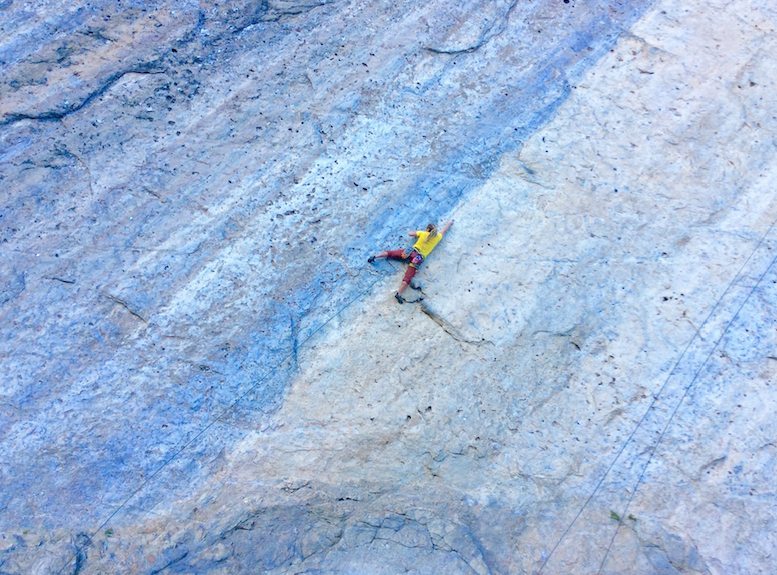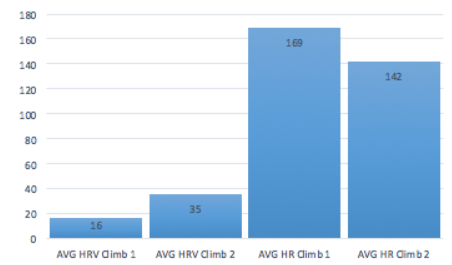
Mountain Athlete Mike Mock climbing at the Fins, Idaho.
By Kyle Bochanski
In March 2016, MTI studied the effect of fear-induced stress on ice climbers.
In June 2016, we conducted a preliminary follow-up study with a rock climber. Our ultimate goal is to develop a research methodology that allows us to determine how much fear contributes to physiological responses (eg. heart rate, breathing rate, etc.) caused by activity in a non-laboratory, mission-direct setting.
For example, when an individual rock climbs, their body adjusts physiologically to – i.e. increased heart rate, increased respiratory rate, perspiration, etc to meet the metabolic or energy demand they require to use their muscles to get up the wall. In rock climbing, however, the climber also has to deal with a mental “fear” aspect from exposure or the fear of falling large heights. This psychological state elicits a physiological response in the same physiological measures identified for supplying muscles with energy. Fear increases respiratory rate, heart rate, perspiration, etc.
Our goal is to identify the extent to which fear influences such physiological measures. Meeting this goal will allow for direct observation of how well someone is controlling their fear in a stressful setting and provide a useful learning tool, applicable to both mountain and tactical athletes.
To find an objective measure of fear we must discriminate the physiological response to fear from the physiological response to the metabolic demand of exercising muscles. For example, if we know that a climber’s heart rate is 160 bpm and metabolic demand accounts for 140 bpm then 20 bpm would be attributable to fear.
In a practical setting, we could theoretically assess better control of fear by observing a heart rate closer to 140 bpm on their next climb (unless better composure is actually completely mental and doesn’t change physiology).
What the Literature Says
There have been multiple attempts to separate the physiological response of fear from metabolic demand for climbers.
A previous study looked at oxygen consumption (VO2) in climbers in order to establish the body’s metabolic demand.1 While this design seems viable superficially, fear increases oxygen consumption which defeats the purpose of finding a physiological measure separate from fear.
In another study, the authors looked at adrenaline (also called epinephrine) and noradrenaline (also called norepinephrine). Their study premise was that adrenaline was indicative of fear and noradrenaline of physical activity.2 The actual physiological and psychological pathways that the hormones represent, however, is controversial.
To avoid this hurdle, a measure of workload has to be external to the body. Thus in most cases, an accelerometer would work just fine. In climbing, however, accelerometers are not accurate in measuring the isometric workloads of the climbers.
Since there seems to be no current measure of metabolic demand that are separate from the effects of fear, the only option left is to have the climber perform the same route twice and assume the workload is exactly the same.
Rock Climbing Mini Study
As mentioned before, we conducted a preliminary study looking at the relationship of heart rate variability (HRV) and heart rate varied levels of fear in rock climbing.
HRV is how your heart rate deviates from a constant rhythm. At 60 beats per minute, we’d assume your heart rate is beating every second.
An example of HRV would be the time between your heart beats changing from a one second interval to a 1.1 second interval to a .9 second interval, etc. rather landing on every second mark exactly.
When relaxed and unstressed, your heart’s beat variability is greater. When stressed by fear, your sympathetic nervous system exerts greater control, and your heartbeat interval becomes very consistent.
We would hypothesize that a climber who exhibits fear has a lower HRV. It is important to note that HRV is affected by exercise as well, which means need to keep the metabolic load consistent for each climb.
To do this we strapped a Zephyr Bioharness to one of our athletes, an elite rock climber and had him attempt a new 5.12 route twice in Idaho.
On the first attempt, the climber fell twice on the route but eventually completed it.
On the second attempt, after a 45-minute rest, the climber completed the route without falling and reported feeling much less anxiety.
From this report, we assumed we would find differences in HRV and HR between the first and second attempt. Specifically, we assumed fear was a much greater factor during the climber’s first attempt – where he fell twice – thus his HRV would be less.
During the second attempt, with his route knowledge established, we assumed fear of falling would be less, and his HRV would be greater.
Looking at the data, we found this to hold true. The overall heart rate decrease for the second climb and HRV increased as shown below.

Additionally, in looking specifically at the first climb with the two falls, we found an interesting pattern in data before the climber fell (shown in the graph below).

The HRV from climb one (orange line) shows the typical decrease in HRV as HR increases but HRV increases quickly again before falling, forming a “double hump” (evident from 11:31 to 16:00). This finding is interesting because it suggests the climber reentered a more relaxed state when he first started climbing just after his fall.
While the data suggests a contribution of fear to HR and HRV, there are many confounding factors to differentiate between metabolic load and fear.5
An example of a confounding factor is the metaboreflex, in which the more static movements in climbing hinder blood flow and elicit a heart rate increase not directly related to oxygen demand.3 Another is the idea that it is difficult to make sure the climber experiences the same metabolic load every time they climb the same route (differing efficiency complicate the picture).
Moving Forward
This mini-study raised several questions to consider as we move forward.
- How do we differentiate between the effect of fear and metabolic load on heart rate in sports where accelerometers are not very accurate? (eg. climbing)
- Is HRV the most valid measure of fear as long as the metabolic load is considered?
- Are there measures of fear that can be easily and completely distinguished from the metabolic load?
- For situations where workload can be reliably quantified (eg. military scenarios), is simply comparing HRV to performance useful for identifying individuals who need training in controlling their stress response? Is heart rate just as valid?
Questions, Comments, Feedback? Email coach@mtntactical.com
References:
- Billat, V., Palleja, P., Charlaix, T., Rizzardo, P. & Janel, N. Energy specificity of rock climbing and aerobic capacity in competitive sport rock climbers. J. Sports Med. Phys. Fitness 35, 20–24 (1995).
- Williams, E. S., Taggart, P. & Carruthers, M. Rock climbing: observations on heart rate and plasma catecholamine concentrations and the influence of oxprenolol. Br. J. Sports Med. 12, 125–128 (1978).
- Sheel, A. W. Physiology of sport rock climbing. Br. J. Sports Med. 38, 355–359 (2004).
- Analysis of Cardiac Output Control in Response to Challenges – Control of Cardiac Output – NCBI Bookshelf. Available at: http://www.ncbi.nlm.nih.gov/books/NBK54474/. (Accessed: 8th June 2016)
YOU MIGHT ALSO LIKE STRESS IS A MAJOR CONTRIBUTOR TO THE PHYSIOLOGICAL DEMANDS OF ICE CLIMBING
STAY UPDATED
Sign-up for our BETA newsletter. Training tips, research updates, videos and articles - and we’ll never sell your info.
